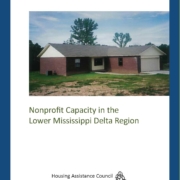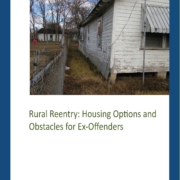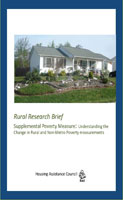HAC News: January 11, 2012
HAC News Formats. pdf, mobi, epub
January 11, 2012
Vol. 41, No. 1
• USDA to close 43 local RD offices under new “blueprint” • HUD offers housing counseling training funds • Changes to HOME regulations proposed • RD adds square footage to “modest housing” determination • Food assistance can be included in Section 502 repayment income • Guidance on unliquidated multifamily housing obligations issued by RD • USDA seeks private investors for rural infrastructure • Comments invited on HMDA, SAFE, and RESPA rules • HUD guidebook addresses combining HOME and NSP • Proposals to align federal rental programs released • Federal Reserve recommends GSEs help stabilize housing market. • HUD reports on elderly households it assists • Affordable Rural Senior Housing addressed in new Rural Voices
January 11, 2012
Vol. 41, No. 1
USDA TO CLOSE 43 LOCAL RD OFFICES UNDER NEW “BLUEPRINT.” On January 9, USDA announced a “Blueprint for Stronger Service” to reduce costs while, the department says, providing better results for its customers. A total of 259 facilities will be closed, including 43 RD offices in 17 states. Visit https://ruralhome.org.
HUD OFFERS HOUSING COUNSELING TRAINING FUNDS. Nonprofits with housing counseling training experience should apply by February 7. See https://www.hud.gov/offices/adm/grants/fundsavail.cfm or https://www.grants.gov. Contact Gerard P. Donahoe, Jr., HUD, gerard.p.donahoe@hud.gov, 202-402-3951.
CHANGES TO HOME REGULATIONS PROPOSED. Comments are due February 14. See Federal Register, 12/16/11, or https://www.regulations.gov. Contact Virginia Sardone, HUD, 202-708-2684. HAC will post its comments at https://ruralhome.org as soon as possible. A National Low Income Housing Coalition summary is posted at https://www.nlihc.org/doc/NLIHC_Proposed_HOME_Reg_Summary_1-5-12.pdf and NLIHC will hold a briefing on January 23 at noon Eastern time; email policyintern@nlihc.org for call-in information.
RD ADDS SQUARE FOOTAGE TO “MODEST HOUSING” DETERMINATION. Because declining market values have allowed larger homes to fit under area loan limits, an Unnumbered Letter dated November 30, 2011 establishes square footage guidelines for Section 502 houses. State offices may not impose additional requirements. The UL is posted at https://ruralhome.org. Contact an RD office.
FOOD ASSISTANCE CAN BE INCLUDED IN SECTION 502 REPAYMENT INCOME. In September RD excluded special-purpose payments from the calculation of income a borrower can use to repay a Section 502 direct loan. A December 14, 2011 Unnumbered Letter allows Supplemental Assistance Nutrition Program (Food Stamps) income as up to 20% of total repayment income. The UL is posted at https://ruralhome.org. Contact an RD office.
GUIDANCE ON UNLIQUIDATED MULTIFAMILY HOUSING OBLIGATIONS ISSUED BY RD. An Unnumbered Letter dated December 7, 2011 says that Section 515 and off-farm 514/516 loans and grants must be fully liquidated within three years after obligation. The requirement for on-farm loans is two years. Visit https://www.rurdev.usda.gov/SupportDocuments/uldecember11.pdf. Contact an RD office.
USDA SEEKS PRIVATE INVESTORS FOR RURAL INFRASTRUCTURE. USDA asks potential investors to contact the department by January 26. It will consider a variety of investment structures to leverage its community facilities loan funds. See Federal Register, 12/27/11. Contact infrastructure.investments@osec.usda.gov.
COMMENTS INVITED ON HMDA, SAFE, AND RESPA RULES. The Consumer Financial Protection Bureau is republishing, without substantive changes, regulations implementing laws previously overseen by other agencies. These include the Home Mortgage Disclosure Act, Secure and Fair Enforcement for Mortgage Licensing Act, and Real Estate Settlement Procedures Act. For HMDA and SAFE, comments are due February 17 and the contact is Mitchell E. Hochberg, CFPB, 202-435-7700. For RESPA, comments are due February 21 and the contact is Joseph Devlin, CFPB, 202-435-7700. See Federal Register, 12/19/11 and 12/20/11, or https://www.regulations.gov.
HUD GUIDEBOOK ADDRESSES COMBINING HOME AND NSP. HOME and NSP: A Guide for Successfully and Effectively Combining Funding Sources explains how to comply with both the HOME and Neighborhood Stabilization Programs when using both, and is posted at https://hudnsphelp.info/media/resources/HOMEandNSP.pdf.
PROPOSALS TO ALIGN FEDERAL RENTAL PROGRAMS RELEASED. A working group of HUD, USDA, and others issued Federal Rental Alignment: Administrative Proposals, describing 10 initiatives to streamline requirements and processes across funding agencies. Visit https://www.huduser.org/portal/aff_rental_hsg/home.html.
FEDERAL RESERVE RECOMMENDS GSES HELP STABILIZE HOUSING MARKET. In a January 4 paper sent to congressional leaders, the Fed outlines directions policymakers might take, while cautioning that economic losses are inevitable. Visit https://www.federalreserve.gov/publications/other-reports/files/housing-white-paper-20120104.pdf.
HUD REPORTS ON ELDERLY HOUSEHOLDS IT ASSISTS. HUD-supported housing occupied primarily by the elderly retained residents until more advanced average ages than housing occupied primarily by non-elderly people. End of Participation in Assisted Housing: What Can We Learn About Aging in Place? is available at https://www.huduser.org/portal/publications/pubasst/locke_aging.html or from HUD User, 1-800-245-2691.
AFFORDABLE RURAL SENIOR HOUSING ADDRESSED IN NEW RURAL VOICES. In the winter issue of HAC’s quarterly magazine, local and national organizations focus on strategies for developing, rehabilitating, and preserving affordable senior housing in rural America. This and other issues of Rural Voices are free at https://www.ruralhome .org. One print subscription per organization is free from Dan Stern, HAC, 202-842-8600, dan@ruralhome.org.



